Caddy 源码全解析
Preface
Caddy 是 Go 语言构建的轻量配置化服务器。同时代码结构由于 Go 语言的轻便简洁,比较易读,推荐学弟学妹学习 Go 的时候也去查看追一下它的源码。不用怕相信这篇文章能给你很大的信心。
可能会有点多,建议多看几遍。
Overview-CaddyMain
当然,建议看这篇文章的时候,查看上手一下 Caddy 的实际配置操作应用,对理解源码会有好处,如果没有操作过也没有关系。
Package
这是 caddy 包的结构
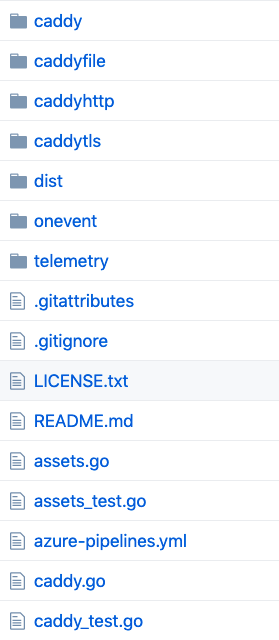
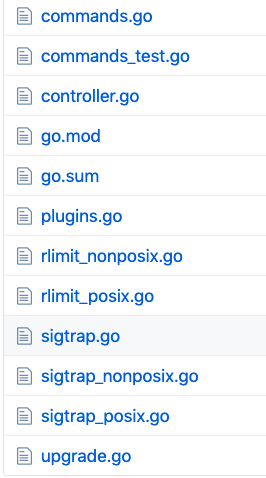
首先我们从一切的开始讲起,即平时我们程序运行的 main.go 函数。
这是 上图 caddy 文件夹下的目录结构。
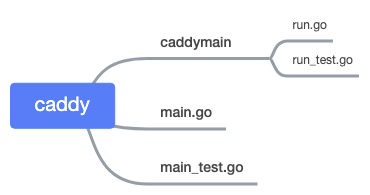
在 caddy 文件夹中的 main 函数启动 caddy 服务器。实际运行的是 run.go 中的文件,这是方便测试使用
看 main.go 的代码
 通过改变 run 变量的值来方便测试,可以学习一下。
通过改变 run 变量的值来方便测试,可以学习一下。
启动流程
启动 caddy 的流程画了张图
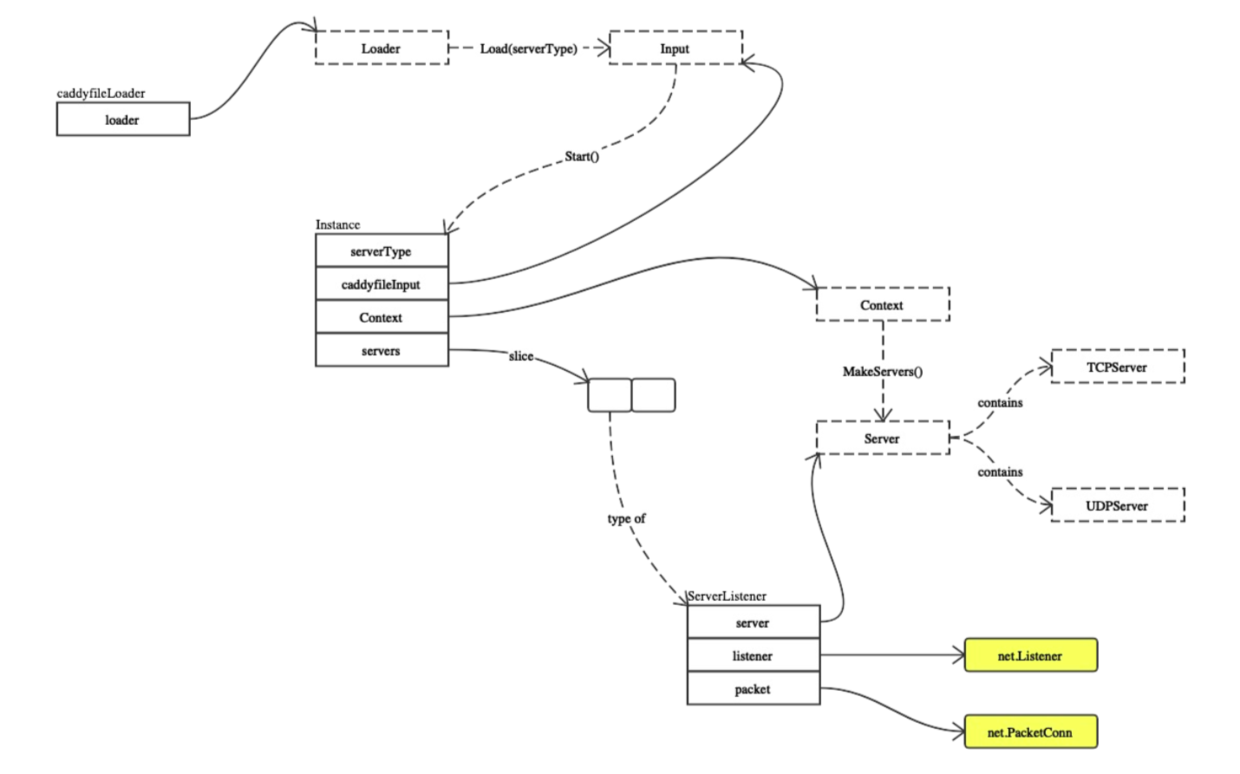
见到不认识的不用担心,查看上文的目录结构可以找到他们大概的位置,下文会详细讲解。
可以在此图中看到几个重要的点 caddyfileLoader这是加载 caddyfile 配置来启动服务器的。
如果配置使用过 caddy ,配置的 caddyfile 就是在这里被 Loader 读取后实例化服务器的。如果没有使用过,大致说一下流程,使用 caddy 非常简单,只需配置上文所说的 caddyfile 文件,按行配置选项,然后使用 caddy 运行读取该配置文件即可。简单示例就是以下的文本。

Instance 是运行操作的实例,可以看到几个主要的操作都是在他身上
Server 可以看到拥有 TCP UDP 两个 Server 的接口。
我们首先关心的是 Start() 启动服务器。
启动服务器
发送 StartupEvent, 参照下文中 Event 理解
// Executes Startup events
caddy.EmitEvent(caddy.StartupEvent, nil)
读取配置文件:
caddyfileinput, err := caddy.LoadCaddyfile(serverType)
启动:
instance, err := caddy.Start(caddyfileinput)
发送 InstanceStartupEvent
caddy.EmitEvent(caddy.InstanceStartupEvent, instance
caddy.Start()
阅读完代码,画一张图帮助理解
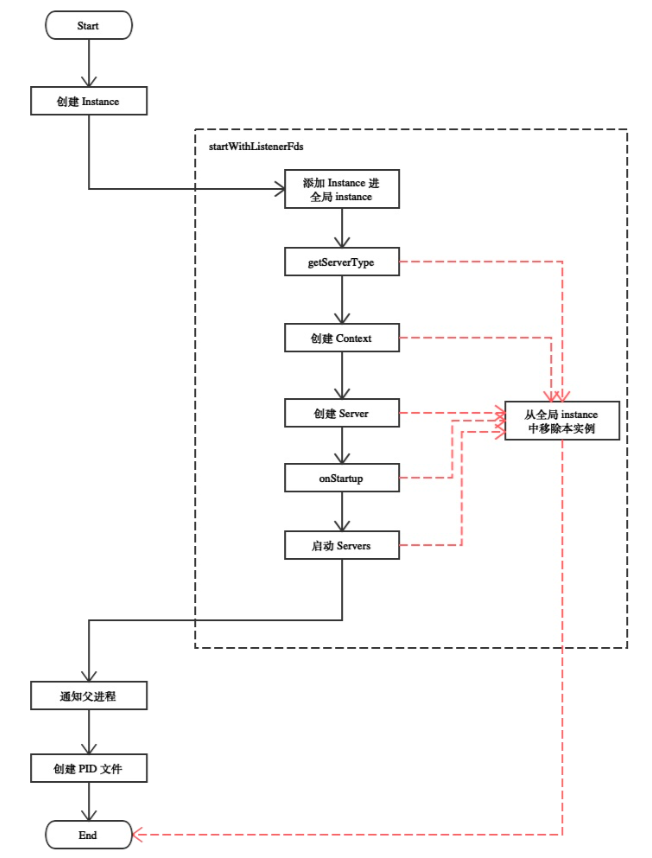 是不是很简单,来一点更详细的交互
是不是很简单,来一点更详细的交互

这里除了 Instance 之外还有两个新名词
Controller:它是用来帮助 Directives 设置它自身的,通过读取 Token,这里的 Directives 实际上对应的就是上文所说的 caddyfile 中的配置文件选项。这一点请参照下文中 Loader 下的 excuteDirective 理解。
Token :是 caddy 自己的 词法分析器 解析 caddyfile 配置文件出的选项的标记。这一点请参照下文中 Loader 中的 Parser 理解
如果不理解,首先记住 caddy 是配置化的服务器,
通过 caddyfile 配置 ->
那么肯定要读取它啦 ->
然后要解析它配置的到底是那些东西 ->
之后呢,就要让配置的目标做到 caddyfile 中声明的更改。
记住这个流程继续看几遍就能理解了。
Server
在 caddy.go 中定义着 Server 的接口,同时实现了优雅的退出。我们首先看图了解组织结构
简单看一下 Stopper 的接口
// Stopper is a type that can stop serving. The stop
// does not necessarily have to be graceful.
type Stopper interface {
// Stop stops the server. It blocks until the
// server is completely stopped.
Stop() error
}
GracefulServer 包含 Stopper 的接口实现了优雅退出,这是拦截了 系统 signal 的信号之后执行的结果,意在意外中断的时候保存好需要保存的东西。
它同时包含着 WrapListener 函数。可以看出,他用来做中间件。
// WrapListener wraps a listener with the
// listener middlewares configured for this
// server, if any.
WrapListener(net.Listener) net.Listener
ServerType
最后看到不同 serverType 生成不同的 server
另外可以看到 这里最重要的 Instance 下面我们进一步查看 Instance 的代码
Instance
instance 是 Server 用来执行操作的实体。首先来看他的结构。它的代码在 主文件夹中的 caddy.go 中
首先我们看一下 它的结构了解下它可能有的功能
struct
type Instance struct {
serverType string
caddyfileInput Input
wg *sync.WaitGroup
context Context
servers []ServerListener
OnFirstStartup []func() error // starting, not as part of a restart
OnStartup []func() error // starting, even as part of a restart
OnRestart []func() error // before restart commences
OnRestartFailed []func() error // if restart failed
OnShutdown []func() error // stopping, even as part of a restart
OnFinalShutdown []func() error // stopping, not as part of a restart
Storage map[interface{}]interface{}
StorageMu sync.RWMutex
}
serverType 代表这个实例的服务器类型,通常是 HTTP
caddyfileInput 是 Input 类型,通常我们配置 caddy 服务器的时候,就是通过编辑 caddyfileInput 的文本实现的修改配置行动。值得注意的是,生成 Instance 的参数同样是 caddyfile,这里的 caddyfile 在程序中是一个接口,一会儿继续讲解
wg 是用来等待所有 servers 执行他们操作的信号量。
context 是实例 Instance的上下文,其中包含 serverType 信息和服务器配置管理状态的信息。
servers 是一组 server 和 他们的 listeners,两种 Server TCP/UDP,即 serverType ,两种不同的 serverType 会对应不同的 caddyfile中的选项。
OnXXX 等 6 个函数是一系列回调函数,通过名字能够看出在什么时候回调触发。
Storage 是存储数据的地方,本来可以设计在 全局状态中,但是设计在这里更好,考虑到垃圾回收机制,进程中重新加载时,旧的 Instance be destroyed 之后,会变成垃圾,收集。这和 12-factor 中的 第九条 Disposability 相符合。意思是每一次重载实例 Instance 即使是在进程中重载,也不会出现数据相互影响到情况,保持幂等。
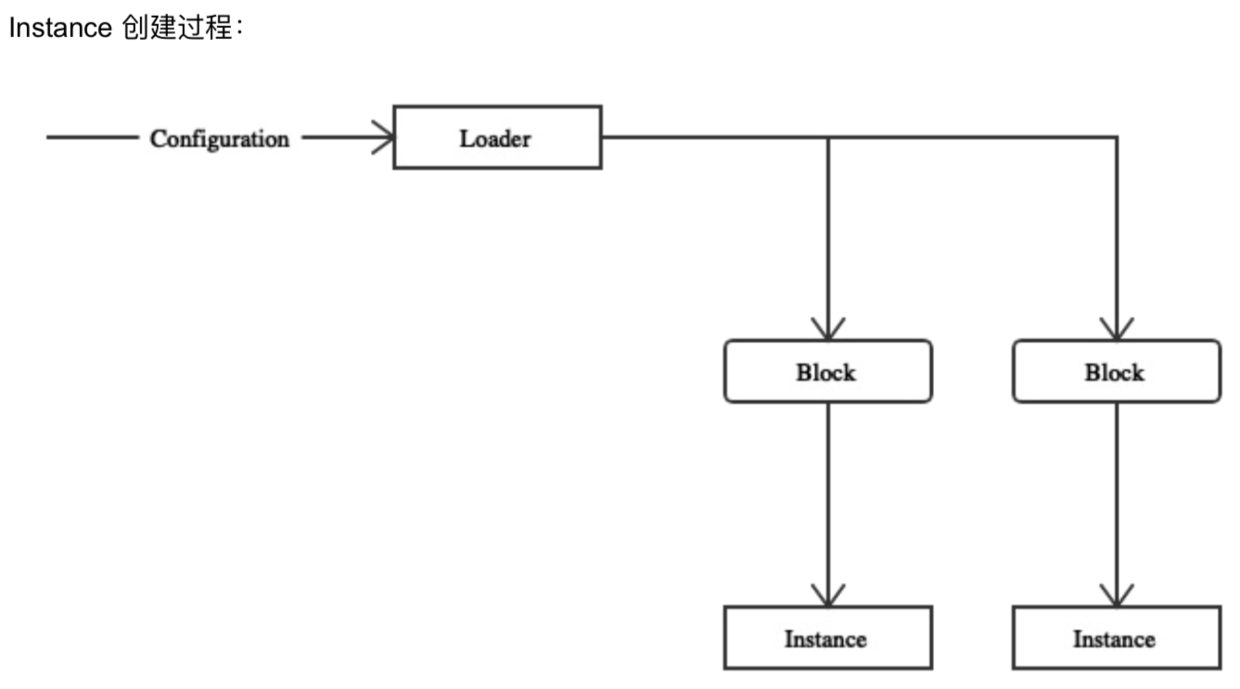 虽然 Instance 操作着众多操作,但是我们却不能从它讲起,从农村包围城市,渐渐了解 Instance 能调用的函数,自然 Instance 的功能就清晰了。
虽然 Instance 操作着众多操作,但是我们却不能从它讲起,从农村包围城市,渐渐了解 Instance 能调用的函数,自然 Instance 的功能就清晰了。
Event
首先上图:
首先我们看到的是 eventHooks 这个结构,实际上他是存储 key:name value:EventHook 这样的一个 map[string]EventHook 的结构,只是从 sync 包中引入保证并发安全。
eventHooks = &sync.Map{}
然后是重要的 caddy.EventHook 结构。
type EventHook func(eventType EventName, eventInfo interface{}) error
然后我们关注到如何注册,和图中的 caddy.EmitEvent
注册与分发
注册 EventHook
可以看到使用 eventHooks.LoadOrStore方法,不必赘述
func RegisterEventHook(name string, hook EventHook){
if name == "" {
panic("event hook must have a name")
}
_, dup := eventHooks.LoadOrStore(name, hook)
if dup {
panic("hook named" + name + "already registered")
}
}
分发 EmitEvent
通过传入函数为参数调用回调函数
// EmitEvent executes the different hooks passing the EventType as an
// argument. This is a blocking function. Hook developers should
// use 'go' keyword if they don't want to block Caddy.
func EmitEvent(event EventName, info interface{}) {
eventHooks.Range(func(k, v interface{}) bool {
err := v.(EventHook)(event, info)
if err != nil {
log.Printf("error on '%s' hook: %v", k.(string), err)
}
return true //注意这里返回的是 true
})
}
这里使用的 Range 函数,实际上是把事件信息给每一个上述提过 map 中的 EventHook 提供参数进行回调执行,按顺序调用,但是如果 传入函数返回 false ,迭代遍历执行就会中断。
可以知道,上文 Overview中启动服务器 所说的发送 caddy.StartupEvent 事件就是调用的
caddy.EmitEvent(caddy.StartupEvent, nil)
讲到这,相信已经对大致的流程有了一点框架的概念。
下面我们继续深入了解 在读取 caddyfile 文件的时候发生了什么。
Loader
自定义的配置文件都会有读取分析。在 caddy 中 由 Loader 执行这一项职能。首先我们看一下它的工作流程。
这个图来源于 plugin.go 文件
可以看到这里通过 Loader 解耦了 caddyfile 文件的读取,所以把它放在了 plugin.go 文件中,作为一个插件注册在 caddy app 中。
这里可以看到最终流程是 name -> caddy.Input 那么这个 Input 是什么呢?
实际上 Input 就是 caddyfile 在代码中的映射。可以理解为,caddyfile 转化为了 Input 给 caddy 读取。谁来读取它呢?
那么干活的主角登场啦!
Parser
这里我们来看,各个流程的终点 Token 是如何被分析出来的,需要知道,这里的 Token 代表着 caddyfile 中的每行选项配置
词法分析
// allTokens lexes the entire input, but does not parse it.
// It returns all the tokens from the input, unstructured
// and in order.
func allTokens(input io.Reader) ([]Token, error) {
l := new(lexer)
err := l.load(input)
if err != nil {
return nil, err
}
var tokens []Token
for l.next() {
tokens = append(tokens, l.token)
}
return tokens, nil
}
这里实际上关键在于 读取,可以看到在 dispenser 中由 cursor 来进行 Token 数组中的迭代
关键在于移动 cursor 索引的函数next()
// next loads the next token into the lexer.
// A token is delimited by whitespace, unless
// the token starts with a quotes character (")
// in which case the token goes until the closing
// quotes (the enclosing quotes are not included).
// Inside quoted strings, quotes may be escaped
// with a preceding \ character. No other chars
// may be escaped. The rest of the line is skipped
// if a "#" character is read in. Returns true if
// a token was loaded; false otherwise.
func (l *lexer) next() bool {
var val []rune
var comment, quoted, escaped bool
makeToken := func() bool {
l.token.Text = string(val)
return true
}
for {
ch, _, err := l.reader.ReadRune()
if err != nil {
if len(val) > 0 {
return makeToken()
}
if err == io.EOF {
return false
}
panic(err)
}
if quoted {
if !escaped {
if ch == '\\' {
escaped = true
continue
} else if ch == '"' {
quoted = false
return makeToken()
}
}
if ch == '\n' {
l.line++
}
if escaped {
// only escape quotes
if ch != '"' {
val = append(val, '\\')
}
}
val = append(val, ch)
escaped = false
continue
}
if unicode.IsSpace(ch) {
if ch == '\r' {
continue
}
if ch == '\n' {
l.line++
comment = false
}
if len(val) > 0 {
return makeToken()
}
continue
}
if ch == '#' {
comment = true
}
if comment {
continue
}
if len(val) == 0 {
l.token = Token{Line: l.line}
if ch == '"' {
quoted = true
continue
}
}
val = append(val, ch)
}
}
理解了 next 函数,就很容易知道如何分析一块选项的 token 了,不过都是 next() 的包装函数罢了。
excuteDirective
func executeDirectives(inst *Instance, filename string,
directives []string, sblocks []caddyfile.ServerBlock, justValidate bool) error {
// map of server block ID to map of directive name to whatever.
storages := make(map[int]map[string]interface{})
// It is crucial that directives are executed in the proper order.
// We loop with the directives on the outer loop so we execute
// a directive for all server blocks before going to the next directive.
// This is important mainly due to the parsing callbacks (below).
for _, dir := range directives {
for i, sb := range sblocks {
var once sync.Once
if _, ok := storages[i]; !ok {
storages[i] = make(map[string]interface{})
}
for j, key := range sb.Keys {
// Execute directive if it is in the server block
if tokens, ok := sb.Tokens[dir]; ok {
controller := &Controller{
instance: inst,
Key: key,
Dispenser: caddyfile.NewDispenserTokens(filename, tokens),
OncePerServerBlock: func(f func() error) error {
var err error
once.Do(func() {
err = f()
})
return err
},
ServerBlockIndex: i,
ServerBlockKeyIndex: j,
ServerBlockKeys: sb.Keys,
ServerBlockStorage: storages[i][dir],
}
setup, err := DirectiveAction(inst.serverType, dir)
if err != nil {
return err
}
err = setup(controller)
if err != nil {
return err
}
storages[i][dir] = controller.ServerBlockStorage // persist for this server block
}
}
}
if !justValidate {
// See if there are any callbacks to execute after this directive
if allCallbacks, ok := parsingCallbacks[inst.serverType]; ok {
callbacks := allCallbacks[dir]
for _, callback := range callbacks {
if err := callback(inst.context); err != nil {
return err
}
}
}
}
}
return nil
}
caddyfile 既然被解析完毕,那么就要开始执行配置更改了,这里实际上是 caddy.go 中的 函数,最后在 caddy 的 main.go 中调用来执行更改。
DirectiveAction
很容易发现,这里是通过 操作 Controller 来实现的,此时可以再返回最上文查看上一次提到 Controller 的时候。
// DirectiveAction gets the action for directive dir of
// server type serverType.
func DirectiveAction(serverType, dir string) (SetupFunc, error) {
if stypePlugins, ok := plugins[serverType]; ok {
if plugin, ok := stypePlugins[dir]; ok {
return plugin.Action, nil
}
}
if genericPlugins, ok := plugins[""]; ok {
if plugin, ok := genericPlugins[dir]; ok {
return plugin.Action, nil
}
}
return nil, fmt.Errorf("no action found for directive '%s' with server type '%s' (missing a plugin?)",
dir, serverType)
}
了解完这些,我们注意到有一个 叫做 Action 的东西,它又是怎么来的?别急,他就在 Plugin 包中。我们知道了,配置文件实际上是配置各种 plugin 作为插件安装在 caddy 服务器上,而 caddyfile 正是被转化为了 Token,Dispenser 来执行配置更改,即不同的插件安装。那么 Action 就是 Plugin 的 SetupFunc啦,来看看吧。
Plugin
你会注意到,在目录中有一个 叫 caddyhttp 的文件夹中的文件夹特别多,不用问,这就是 http 的可选 Plugin 啦
Overview
这里概览了 Plugin 是如何注册的。
可以在这里看到我们之前讲解的很多的熟悉的概念,这是因为我们快要读完 caddy 的架构了,剩下的实际上是具体的 Plugin 的各种扩展实现了。
可以看到,Plugin 是注册在不同的 服务器类型 serverType 下的,实际上是在两重 map 映射的结构中,图中可以看出,然后是 Action ,最近的上文才说明了它,用它来进行 Plugin 的安装。
然后来到 Controller ,实际进行配置的家伙,看到了之前所说的 Dispenser 和 Token 配置,还记得吗,他们在刚才的词法分析里才出现过。
接下来我们看一个 HTTP 的 Plugin 的例子 errors 的实现
caddyHTTP
errors
这里我们从下看,caddy.Listener 定义在 caddy.go 中,用来支持 零停机时间加载。
往上看到 Middleware 调用,我们来看看 errorsHandle 的结构
// ErrorHandler handles HTTP errors (and errors from other middleware).
type ErrorHandler struct {
Next httpserver.Handler
GenericErrorPage string // default error page filename
ErrorPages map[int]string // map of status code to filename
Log *httpserver.Logger
Debug bool // if true, errors are written out to client rather than to a log
}
可以看到,Next 字段明显是 Chain 调用的下一个 Handler 处理。事实上,每一个 Plugin 或者算是 HTTP 服务中的中间件都有这个字段用于 构建链式调用。
每一个 Plugin 值得注意的两个,
一个是他们会实现 ServeHTTP 接口进行 HTTP 请求处理。
func (h ErrorHandler) ServeHTTP(w http.ResponseWriter, r *http.Request) (int, error) {
defer h.recovery(w, r)
status, err := h.Next.ServeHTTP(w, r)
if err != nil {
errMsg := fmt.Sprintf("%s [ERROR %d %s] %v", time.Now().Format(timeFormat), status, r.URL.Path, err)
if h.Debug {
// Write error to response instead of to log
w.Header().Set("Content-Type", "text/plain; charset=utf-8")
w.WriteHeader(status)
fmt.Fprintln(w, errMsg)
return 0, err // returning 0 signals that a response has been written
}
h.Log.Println(errMsg)
}
if status >= 400 {
h.errorPage(w, r, status)
return 0, err
}
return status, err
}
另一个是安装到 caddy 中的 setup.go 文件,我们看一下 Plugin 安装的全流程。
Directives
前面提到过很多次 Directives 这里做一个它的整个流程概览。上文中提到,这些注册实际上都是 Controller 执行的。下半部分是 关于 HTTP 的服务配置
这里的重点在 errors.serup() 可以看到,它创建了 errors.ErrHandler 并注册到了 httpserver 的一对中间件中
// setup configures a new errors middleware instance.
func setup(c *caddy.Controller) error {
handler, err := errorsParse(c)
···
httpserver.GetConfig(c).AddMiddleware(func(next httpserver.Handler) httpserver.Handler {
handler.Next = next
return handler
})
return nil
}
实际上这里还有一个关于 caddy.Controller 到 ErrorHandler 的一个转换 通过 errorsParse 函数
谢谢阅读,如果有不对的地方欢迎指正。
有疑问加站长微信联系(非本文作者))


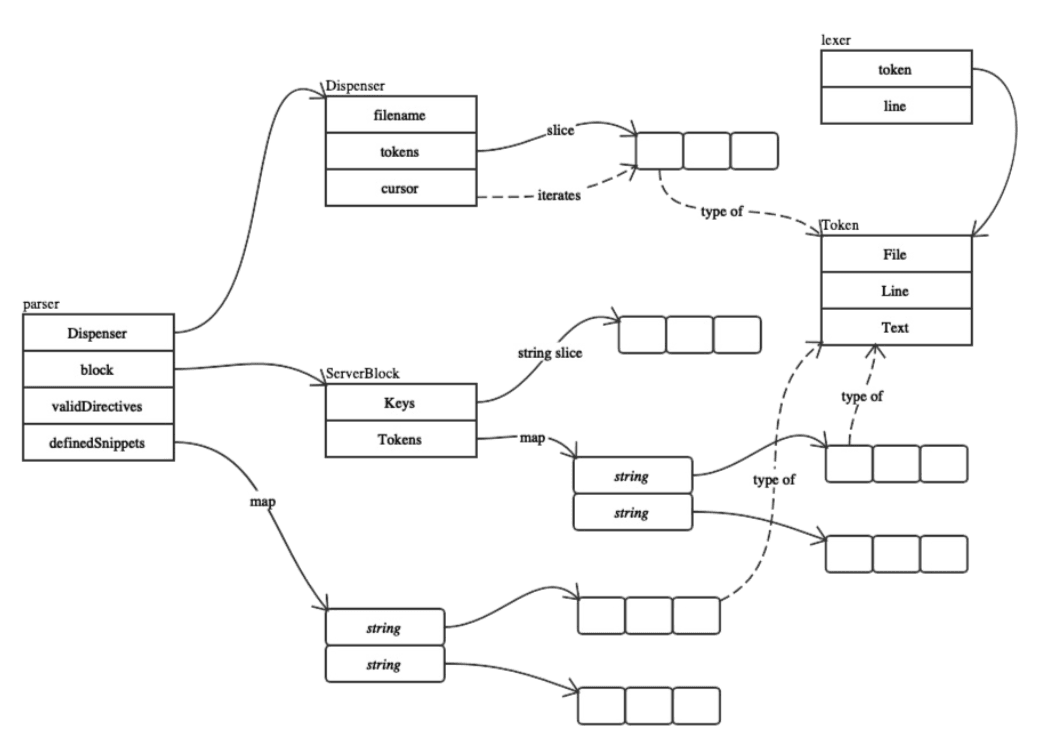
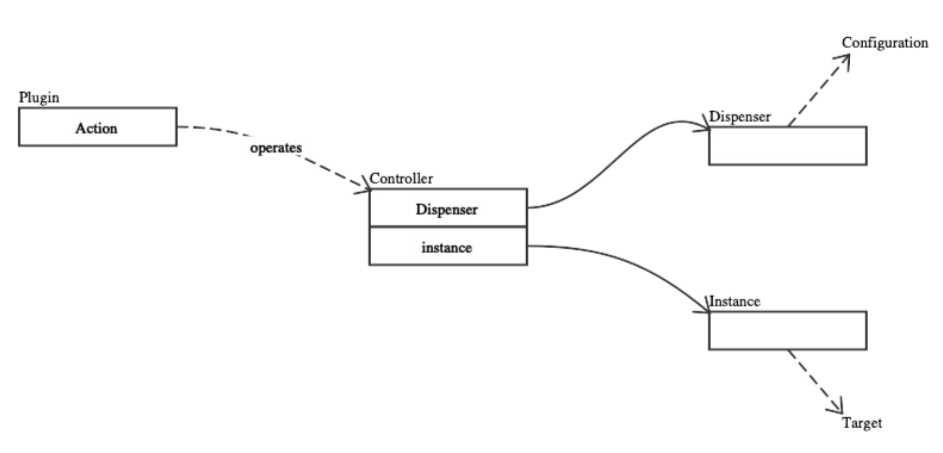






查看原文获得更好阅读体验